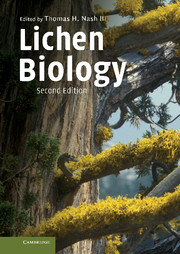Book contents
- Frontmatter
- Contents
- List of contributors
- Preface
- 1 Introduction
- 2 Photobionts
- 3 Mycobionts
- 4 Thallus morphology and anatomy
- 5 Morphogenesis
- 6 Sexual reproduction in lichen-forming ascomycetes
- 7 Biochemistry and secondary metabolites
- 8 Stress physiology and the symbiosis
- 9 Physiological ecology of carbon dioxide exchange
- 10 The carbon economy of lichens
- 11 Nitrogen, its metabolism and potential contribution to ecosystems
- 12 Nutrients, elemental accumulation, and mineral cycling
- 13 Individuals and populations of lichens
- 14 Environmental role of lichens
- 15 Lichen sensitivity to air pollution
- 16 Lichen biogeography
- 17 Systematics of lichenized fungi
- Appendix: Culture methods for lichens and lichen symbionts
- References
- Taxon index
- Subject index
8 - Stress physiology and the symbiosis
Published online by Cambridge University Press: 05 September 2012
- Frontmatter
- Contents
- List of contributors
- Preface
- 1 Introduction
- 2 Photobionts
- 3 Mycobionts
- 4 Thallus morphology and anatomy
- 5 Morphogenesis
- 6 Sexual reproduction in lichen-forming ascomycetes
- 7 Biochemistry and secondary metabolites
- 8 Stress physiology and the symbiosis
- 9 Physiological ecology of carbon dioxide exchange
- 10 The carbon economy of lichens
- 11 Nitrogen, its metabolism and potential contribution to ecosystems
- 12 Nutrients, elemental accumulation, and mineral cycling
- 13 Individuals and populations of lichens
- 14 Environmental role of lichens
- 15 Lichen sensitivity to air pollution
- 16 Lichen biogeography
- 17 Systematics of lichenized fungi
- Appendix: Culture methods for lichens and lichen symbionts
- References
- Taxon index
- Subject index
Summary
Lichens are the dominant life forms in about 8% of the land surface of the Earth (Ahmadjian 1995), mainly in polar regions and on the tops of mountains. These places are characterized by severe abiotic stresses such as desiccation, temperature extremes, and high light intensities. Arguably, what really makes lichens special, and what separates them from most other eukaryotic organisms, is their ability to tolerate extreme stresses. For this reason, some have called lichens “extremophiles,” organisms that can thrive in conditions that would kill other, less specialized organisms. Scientists have found that hardy lichens can survive a trip into space, and now the list of natural astronauts includes lichens. During a recent experiment by the European Space Agency, lichen astronauts were placed on board a rocket and launched into space, where they were exposed to vacuum, extreme temperatures, and ultraviolet radiation for two weeks. Upon analysis, it appeared that the lichens handled their spaceflight just fine (Young 2005)!
In the typical environments that many lichens inhabit, stresses such as low thallus water content and temperature extremes can develop within just a few minutes. However, others, such as a nutrient deficiency, can take months to develop. The stressfulness of a particular habitat is the result of the interaction of climate and substrate. It plays a major role in determining lichen distribution. Understanding the physiological processes that lie behind stress injury, and how lichens tolerate environmental stress, is therefore of great importance in lichen biology.
- Type
- Chapter
- Information
- Lichen Biology , pp. 134 - 151Publisher: Cambridge University PressPrint publication year: 2008
- 45
- Cited by

